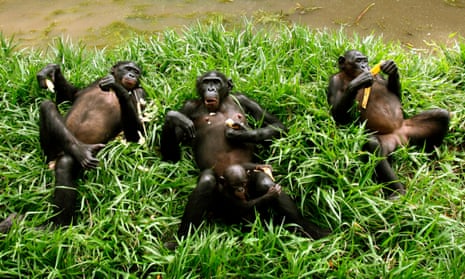The evolutionary history of the bacteria in your guts predates the appearance of humans, and mirrors that of our great ape relatives, according to a genetic study.
The research suggests that microbes in our ancestors’ intestines split into new evolutionary lineages in parallel with splits in the ape family tree.
This came as a surprise to scientists, who had thought that most of our gut bacteria came from our surroundings - what we eat, where we live, even what kind of medicine we take. The new research suggests that evolutionary history is much more important than previously thought.
“When there were no humans or gorillas, just ancestral African apes, they harboured gut bacteria. Then the apes split into different branches, and there was also a parallel divergence of different gut bacteria,” said Prof Andrew Moeller of the University of California, Berkeley who led the study, published in Science. This happened when gorillas separated somewhere between 10-15 million years ago, and again when humans split from chimps and bonobos 5 million years ago.
To understand the evolutionary relationships between gut bacteria in different ape species, the researchers dug through faecal samples from Tanzanian chimps, Cameroonian gorillas, Congolese bonobos and humans from Connecticut. They then ran genetic tests on three different groups of bacteria, which make up about 20% of the human gut bacteria in total.
By looking at a gene called gyrase B, the scientists found that when a common ancestor became two new species, at least two of the groups of gut bacteria appear to have done the same. “We evolved and our gut bacteria evolved with us,” said Moeller.
In biological terms, this evolution of two species together is known as cospeciation, and very few examples of it exist.
“I think it’s really interesting, because it’s been difficult to find signatures of cospeciation,” said Ran Blekhman, an assistant professor in human genomics at the University of Minnesota, who was not involved in the study.
“There are a number of studies that have looked at primates and other species and found evidence. But I think this is the strongest evidence I’ve seen for primates.”
Moeller believes further studies of our inner microbes could reveal whether there are common bacterial ancestors for other mammals too, and maybe help us build a clearer picture of early human migration.
“If our gut bacteria have been tracing our human lineage for millions of years, it could be used to reconstruct the path of human migration. Different populations likely have different strains of the gut bacteria,” he said said, noting that a comparative sample of human gut bacteria in Malawi showed slightly different microbiomes than the Americans.
That, he adds, could have implications for the burgeoning use of faecal transplants - often used in patients whose own gut bacteria have been suppressed with antibiotics. “It’s a very positive enterprise, but our results suggest those efforts need to consider that our bacteria are tracking our lineage.”

Comments (…)
Sign in or create your Guardian account to join the discussion